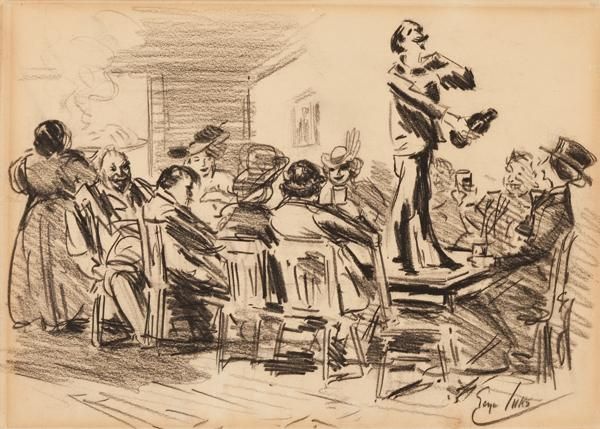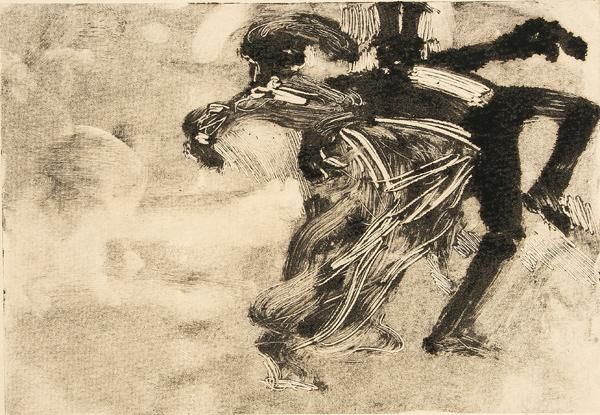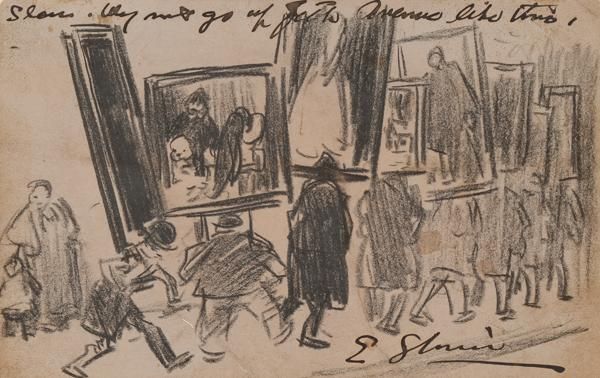Earlier this week, I was talking to one of my colleagues who just came back from being on sabbatical, and he said that the most annoying thing about being on sabbatical was being asked, “So where are you traveling?” Don’t I know the feeling!
Since my sabbatical began this past summer, I have made one (1) research trip, to the wonderful Billy Ireland Comics Library and Museum, at the Ohio State University in bucolic Columbus, OH. I spent a week there in June. Over the past weekend, I decided, somewhat on the spur of the moment, to go on the first of what will probably several short trips to Wilmington, DE, of all places. See the wonderful, exotic places you’ll travel if you become an English professor? Mmm-hmm.
It turns out the Delaware Art Museum in Wilmington has a great collection of artworks, notebooks, papers, and other archival materials relating to the artists I am writing about in my book, How the Other Half Laughs. Having finished the drafts of the chapters relating to comic strips, I’m now turning to those that relate more to magazine and newspaper illustration during the golden years of yellow journalism (1895-1910), focusing right now on the work of George Luks and William Glackens. They were part of a group of painters called, variously, “The Eight” (the name they gave themselves) or “The Ashcan School” (the name given to them by art critics). They got this latter name because they believed that one could (and should) find beauty in everyday reality, whether that reality consisted of panoramic vistas or, well, ashcans piled in alleys. They were quite democratically minded, these Ashcan-ers. Artists of the people, and all that–or so they wanted to be.

I’m spending Thursday and Friday at the museum, and in preparation, I’ve been feeling like I’m kind of cramming for a final exam. It’s been a while since I’ve really looked at stuff by these artists, and I want to make sure I have at least the basic outlines down so that I’ll have a sense of what I’m looking at when I’m at the museum and also, what to tell the curators and librarians that I’d like to look at.
This is my first time doing research in an art museum, so I’m quite excited. But I’m also not quite sure how to go about things. For example, in literature, usually you have many, many copies of texts– the same text, whether it’s The Great Gatsby or Ulysses or Wise Blood– to choose from. But in the art world, there’s often just one copy. One sculpture. One painting. And trying to figure out what is where, who has what, what you can see, and what you can’t—much less what you will be allowed to reproduce in a book of your own—is a crazy mess. In this online, everything-“e” age, art history is a throwback to a different time, when individual objects mattered, when the substance and presence of the object, mattered.
To this end, I’m hoping to look at sketches, drawings, prints, and paintings by Luks and Glackens–along with the kinds of text-based materials I am used to: letters, clippings, notebooks, and so on. So I’m trying to figure out exactly what the museum has, and how those things match up with the questions I am trying to answer with my research.
In the midst of my preparations, I’ve discovered that Pinterest is not just a waste of time (though it’s certainly great for that!), but can actually serve as a valuable research tool.
I just joined Pinterest a couple of weeks ago, because some of the Christmas-present-cum-crafting ideas I ran across on the web seemed accessible only via Pinterest. If you visit my Pinterest page, you’ll see that I have not pinned a single craft idea. (Bad Pinner!) But I have discovered that it’s great for making note of recipes you might want to try … or, things you want to look at in an art archive. It’s so much easier than taking notes of item numbers and so on, or downloading images and saving them with file names, or, to be really 20th century, printing out web pages. So far I have pinned over twenty images I want to be sure to look at while I’m at the museum.
If you’re not on Pinterest, no need to join in order to see what I want to look at. Three that I am especially interested to see are these–all drawings and prints:



The American art curator at the museum, Heather Campbell Coyle, has also told me about various cartoons and puzzles that John Sloan did while working at the Philadelphia Press in the 1890s. Here’s the only one they have in color:

How is it a puzzle? Well, the good people at the Delaware Art Museum have posted about it–check out their blog post and you can find out!
All pretty cool stuff. I’m excited. I’ll let you know how it goes! In the meantime, I’ll be pinning away 😉
And if you are on Pinterest, I’ll just say that I highly recommend the recipe for caraway rye bread at King Arthur Flour I posted. Here’s the bread I made last week (apologies to FB friends who have been subjected to this already):
I’ve tried … and failed … to make rye bread many times. I think the key to this recipe is the vital wheat gluten– what Matt calls “the hippie ingredient.” So let’s hear it for the hippies!




I also am very interested in the Eight and the cartoons (and also have done research in the Sloan Archives in Wilmington). Have you run across a card by George Luks that shows Henri “conducting” the Eight? I have an old 35mm slide with the image, but there is no notation where the original image is located.
LikeLike
So great to “e-meet” you! And great to know of others doing research on these artists. I’ve seen that cartoon … I think I saw it as the frontispiece to a book on The Eight. I had assumed that it was at DAM, but perhaps not? Luks’s materials are scattered all over the place, unfortunately. If you have a slide image, you’re lucky! Hang onto that ;-)!
LikeLike